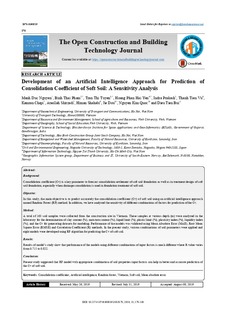| dc.contributor.author | Nguyen, Manh Duc | |
| dc.contributor.author | Pham, Binh Thai | |
| dc.contributor.author | Tuyen, Tran Thi | |
| dc.contributor.author | Yen, Hoang Phan Hai | |
| dc.contributor.author | Prakash, Indra | |
| dc.contributor.author | Vu, Thanh Tien | |
| dc.contributor.author | Chapi, Kamran | |
| dc.contributor.author | Shirzadi, Ataollah | |
| dc.contributor.author | Dou, Jie | |
| dc.contributor.author | Shahabi, Himan | |
| dc.contributor.author | Quoc, Nguyen Kim | |
| dc.contributor.author | Tien Bui, Dieu | |
| dc.date.accessioned | 2019-11-18T09:31:11Z | |
| dc.date.available | 2019-11-18T09:31:11Z | |
| dc.date.created | 2019-10-21T15:02:39Z | |
| dc.date.issued | 2019 | |
| dc.identifier.citation | Open Construction & Building Technology Journal. 2019, 13, 178-188. | nb_NO |
| dc.identifier.issn | 1874-8368 | |
| dc.identifier.uri | http://hdl.handle.net/11250/2628912 | |
| dc.description | This is an open access article distributed under the terms of the Creative Commons Attribution 4.0 International Public License (CC-BY 4.0), | nb_NO |
| dc.description.abstract | Background:
Consolidation coefficient (Cv) is a key parameter to forecast consolidation settlement of soft soil foundation as well as in treatment design of soft soil foundation, especially when drainage consolidation is used in foundation treatment of soft soil.
Objective:
In this study, the main objective is to predict accurately the consolidation coefficient (Cv) of soft soil using an artificial intelligence approach named Random Forest (RF) method. In addition, we have analyzed the sensitivity of different combinations of factors for prediction of the Cv.
Method:
A total of 163 soil samples were collected from the construction site in Vietnam. These samples at various depth (m) were analyzed in the laboratory for the determination of clay content (%), moisture content (%), liquid limit (%), plastic limit (%), plasticity index (%), liquidity index (%), and the Cv for generating datasets for modeling. Performance of the models was validated using Mean Absolute Error (MAE), Root Mean Square Error (RMSE) and Correlation Coefficient (R) methods. In the present study, various combinations of soil parameters were applied and eight models were developed using RF algorithm for predicting the Cv of soft soil.
Results:
Results of model’s study show that performance of the models using different combinations of input factors is much different where R value varies from 0.715 to 0.822.
Conclusion:
Present study suggested that RF model with appropriate combination of soil properties input factors can help in better and accurate prediction of the Cv of soft soil. | nb_NO |
| dc.language.iso | eng | nb_NO |
| dc.rights | Navngivelse 4.0 Internasjonal | * |
| dc.rights.uri | http://creativecommons.org/licenses/by/4.0/deed.no | * |
| dc.title | Development of an Artificial Intelligence Approach for Prediction of Consolidation Coefficient of Soft Soil: A Sensitivity Analysis | nb_NO |
| dc.type | Journal article | nb_NO |
| dc.description.version | publishedVersion | nb_NO |
| dc.rights.holder | © 2019 Nguyen et al. | nb_NO |
| dc.source.pagenumber | 178-188 | nb_NO |
| dc.source.volume | 13 | nb_NO |
| dc.source.journal | Open Construction & Building Technology Journal | nb_NO |
| dc.identifier.doi | 10.2174/1874836801913010178 | |
| dc.identifier.cristin | 1739171 | |
| cristin.unitcode | 222,57,1,0 | |
| cristin.unitname | Institutt for økonomi og IT | |
| cristin.ispublished | true | |
| cristin.fulltext | original | |
| cristin.qualitycode | 0 | |

